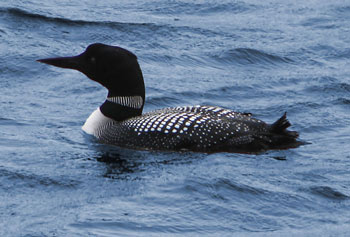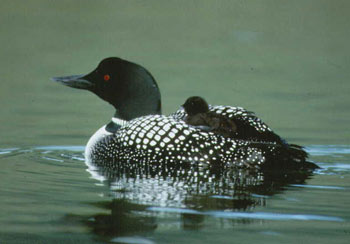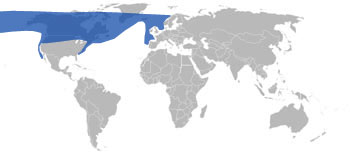
Photographer: P199


Great Northern Diver Range Map
(N America, Greenland & W Europe)
|
| Latin Name |
Gavia immer |
| Conservation Status |
Least Concern |
| Location
| N America, Greenland & W Europe |
| Colour |
See Below |
| Length |
70 - 90 cm (28 - 35 inches) |
| Wingspan |
122 - 152 cm (48 - 60 inches) |
| Weight |
3 - 4.5 Kgs (6.5 - 10 lbs) |
| Life Expectancy |
Up to 9 Yrs |
Main Characteristics
The Great Northern Diver is a large member of the diver family. They have a length between 70 and 90 cms (28 - 35 inches), a wingspan between 122 and 152 cms (48 - 60 inches) and they weigh between 3 and 4.5 kgs (6.5 - 10 lbs).
They have a streamline head and body that is suitable for diving and dense plumage. During the breeding season they are coloured black, grey and white with a black bill but their non-breeding plumage is brownish/grey with a white chin and fore neck and a grey bill.
Their eyes are red in colour and they have a thick, dagger-like bill. They have strong, webbed feet and their legs are set far back on their body. This is particularly useful when diving, but when they are on land they have a clumsy, ungainly walk.
They swim gracefully on the surface of the water and can fly well. They need a long distance to gain momentum for take off and when they land on the water they skim along on their bellies to slow down. Great Northern Divers have distinctive, wailing, laughing calls.
Habitat
Great Northern Divers are found in northern North America, Greenland and Iceland during the breeding season and they migrate to the coasts of north west Europe and North America for the winter period.
They are either solitary or found in pairs but sometimes they gather in larger groups when migrating.
During the breeding season a pair will defend a territory of 0.25 - 0.80 sq. kms (0.1 - 0.31 sq miles) and when they reach their wintering grounds an individual will defend a feeding territory of 0.04 - 0.08 sq. kms (0.02 - 0.03 sq. miles).
Diet
Great Northern Divers are primarily fish eaters and their diet mainly consists of pike, perch, sunfish, trout and bass in freshwater habitats, and in salt water habitats rock fish, sea trout, herring and flounder. They also feed upon aquatic invertebrates.
They catch they prey by diving underwater to depths of 60 m (200 ft) and they seize or sometimes spear fish with their strong bill.
Breeding
Great Northern Divers breed during spring and both the male and female construct a nest in a sheltered location near deep water. The nest is made from soil, moss, grass and vegetation and it is approximately 60 cms (24 inches) in diameter.
1 - 3 brown eggs are laid and both parents incubate them for approximately 29 days. Upon hatching, the chicks remain in the nest for a couple of days then they leave with their parents and rarely return to shore. Sometimes the chicks will ride on the back of one of their parents and they are able to make short dives at 2 days old.
The chicks are able to fly at 2 - 3 months old and it is at this time that they become independent. Great Northern Divers become sexually mature at 2 - 3 years of age.
Predators
Predators of Great Northern Divers include hawks, eagles, and sea otters. Their eggs and chicks often fall prey to gulls, crows, ravens, hawks, eagles, raccoons, skunks, mink, weasels and snapping turtles.
Subspecies
There are no subspecies of the Great Northern Diver.
Interesting Facts
Great Northern Divers are also known as:
Common Loon (in North America)
Great Northern Loon
Polar Loon
Colimbo Mayor (Spanish)
Plongeon Huard (French)
Big Loon
Black-Billed Loon
Call-up-a-storm
Ember Goose
Greenhead
Guinea Duck
Imber Diver
Ring-necked Loon
Walloon
Great Northern Divers are well known in Canada and they are found on the "loonie" coin, the previous series of $20 notes and they are the provincial bird of Ontario.
Great Northern Divers or Common Loons are the state bird of Minnesota.
Similar Birds
Red-Throated Diver
Black-Throated Diver
Pacific Diver
White-Billed Diver
|
|